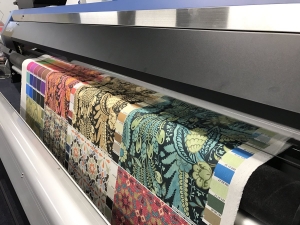Cons & Pros of using pigment ink

Pigment ink has waterproof properties, it's ideal to use such ink to print dark and light cotton materials using transfer papers. Most printers with pigment ink provide eight ink colors: black, light gray, medium gray, yellow, magenta, light magenta, cyan, and light cyan. Compared to dye inks, pigments last longer.
One of the major drawbacks of pigment ink is, it doesn't look the same from different viewing angles; you will notice a bit greenish or bronze color cast from different sides and lighting conditions. Although the ink offers a narrower color gamut, it's much more stable than sublimation inks in long terms.

Pigment inks are usually susceptible to metamerism, which causes it to shift colors under different lighting conditions.
Due to the large size of pigment particles, they cannot seep into the surface. The inkjet receptor top coat allows the ink to attach to the surface that causes higher media costs.
As pigment inks stay on top of the surface instead completely seeped or absorbed into the surfaces, cotton and natural fabrics fit best with them. Polyester fabrics are not ideal for such ink to apply on.
For bonding onto the surfaces, you would require an inkjet printer or binder or heat press machine to do that. When it comes to print any documents, nothing beats pigment inks.
Advantages of Using Pigment Inks
More stable than most dye inks
More resistant to light, humidity, and oxidation
Looks stunning on cotton and natural fabrics
Disadvantages of Using Pigment Inks
Provides less vibrant colors
Reflects the light due to the larger size of particles
Changes the appearance if applied on glossy paper or polyester fabrics
Expensive option
Considering Longevity
Both the inks are durable in different fields. In dark conditions, they both will last up to 100 years without any issue. However, if the bright and outdoor lighting condition is what you are considering, sublimation inks take the lead here.


评论
发表评论